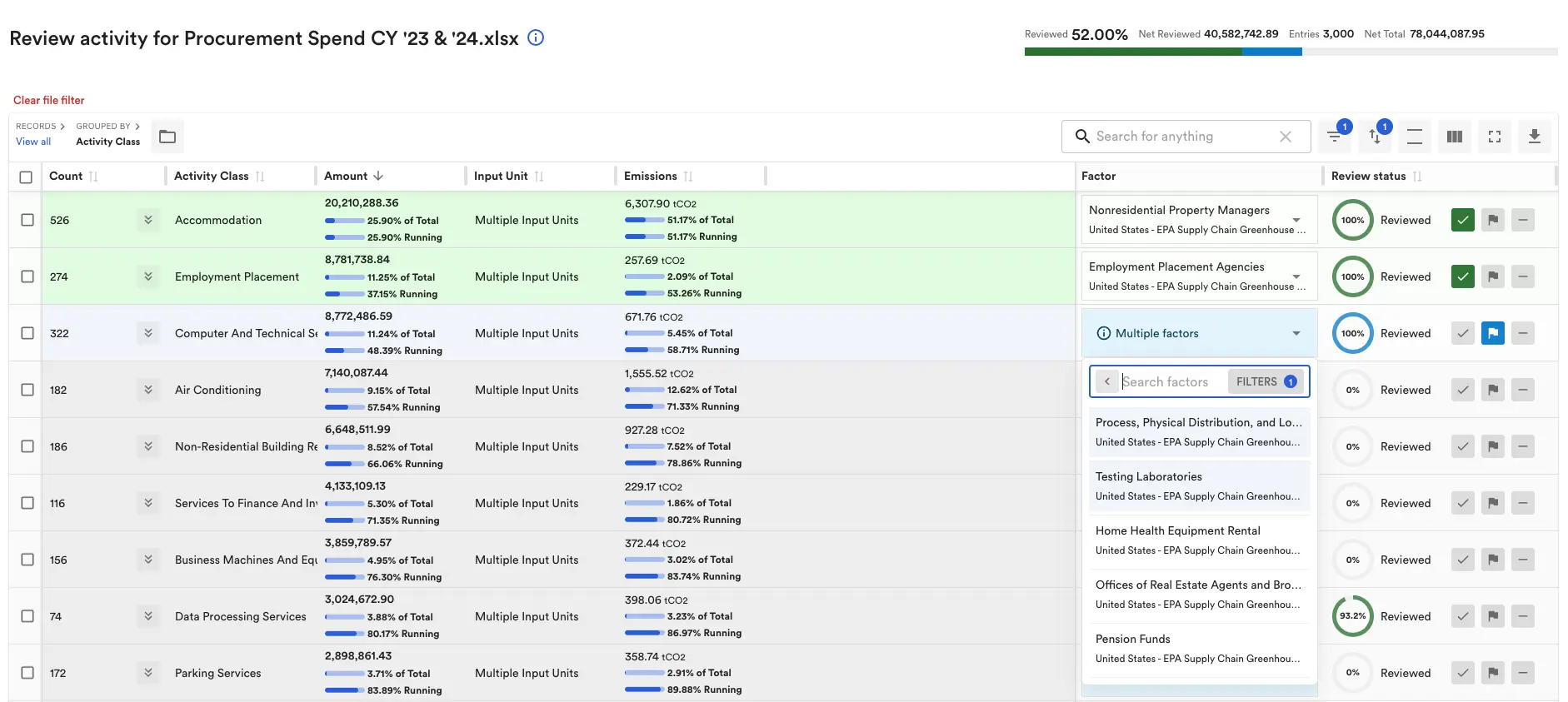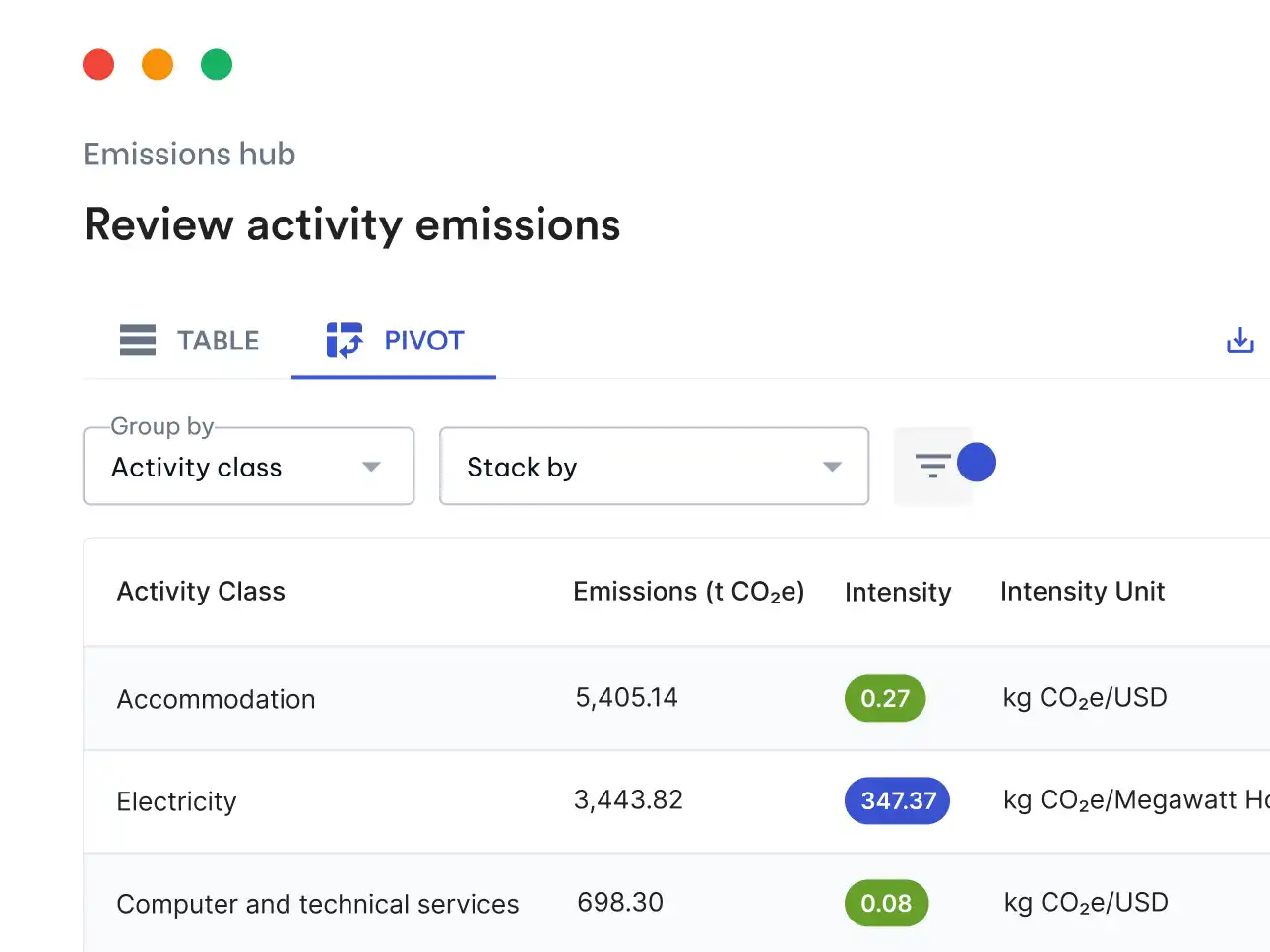Carbon accounting can be time-consuming, especially when done manually. While Avarni simplifies this process, we know many still rely on spreadsheets. This article offers guidance, and you can also explore our comprehensive list of global emission factor databases to find the data you need in one place.
Selecting emission factors is a critical step in building an accurate carbon inventory for your clients, especially under the Greenhouse Gas (GHG) Protocol. Emission factors allow organizations to translate data from various business activities into CO₂-equivalent emissions. However, not all emission factors are equally suitable, and using the wrong factor can result in inaccurate emissions estimates, skewing sustainability goals and reporting.
Choosing the right emission factors for Scope 3 Purchased Goods and Services (Category 1) requires prioritizing several attributes, balancing accuracy, relevance, and usability. Here, we'll explore how to prioritize these attributes effectively to build a reliable emissions inventory for your client.
Key attributes for choosing emission factors
When selecting emission factors for business activities, focus on the following attributes in order of importance (1 is most important, 5 is least important):
- Factor industry match
- Model updates
- Country-level accounting
- Producer vs. purchaser reflection
- Adjustments for industry-level inflation
Let’s break down each of these factors and see how they impact your emissions reporting.
Factor industry match: The most critical consideration
The alignment between the chosen emission factor and the specific industry or activity is by far the most important consideration. For example, if your business operates in agriculture, an emission factor tailored to crop production will yield more accurate results than a generic factor for food production. A close fit ensures that the emissions intensity specific to that industry’s processes and materials is accurately represented.
Why it matters:
The closer the factor aligns with the activity, the fewer adjustments are required to match actual emissions. For example, different types of manufacturing processes or energy sources have distinct emissions profiles. Using a non-specific factor risks both overestimating and underestimating emissions.
How to apply this:
When reviewing potential databases, prioritize those that offer a granular breakdown of factors by industry category. For instance, the EPA or DEFRA databases provide detailed factors for various sub-industries, making them preferable for high-accuracy inventories.
Updates to the base model
Emission factors are periodically updated to reflect current data and industry standards. Using outdated factors may result in inaccuracies, as emissions intensities for certain activities change over time due to technology improvements, regulatory shifts, or other factors. For instance, energy production factors may shift as renewable sources increase their share of the energy grid, leading to lower associated emissions per kWh.
Why it matters:
Recent data gives a more accurate picture of emissions, ensuring that your calculations remain relevant and reflect modern practices. Regular updates are essential for organizations aiming to monitor and reduce emissions over time.
How to apply this:
Verify that the emission factors you use are from the most recent year available. For spend-based factors, if the factors are several years old, make sure you apply inflation adjustments, or use an alternative source with more recent data. DEFRA and ecoinvent, for example, frequently update their emissions factors to maintain accuracy.
Country-level accounting
Using country-specific factors is valuable for organizations with international operations. Different countries have unique production practices, energy sources, and regulatory environments, which significantly impact emissions. By using country-specific factors, companies can capture these regional variations more accurately.
Why it matters:
Country-level specificity ensures that factors better reflect local conditions and emissions intensities. For instance, emissions from electricity use will vary depending on the country’s energy mix—some countries rely more on fossil fuels, while others have higher renewable energy penetration.
How to apply this:
Select databases that offer country-specific factors, especially if your operations span multiple regions. The EXIOBASE spend-based database, for example, is beneficial for multinational companies because it includes region-specific factors for a wide range of goods and services.
Producer vs. purchaser reflection
When choosing emission factors, it's essential to recognize the difference between emissions associated with the production of a product and those at the point of purchase. Often, consumer-facing products carry emissions associated with retail or distribution processes that may not be relevant for emissions tracking purposes in some industries.
Why it matters:
Factors that reflect the "producer" perspective (i.e., the emissions from creating the product) are generally more accurate for Scope 3 emissions reporting, where the focus is on upstream activities rather than retail emissions.
How to apply this:
Ensure that factors chosen for Scope 3 emissions, such as those for purchased goods and services, reflect the producer's emissions. For instance, databases like the EPA’s EEIO include factors at the production level, which are suitable for Scope 3 inventory building, as opposed to factors that might inflate emissions by including retail markups.
Adjustments for inflation at the industry level
If the emission factors in your chosen database are outdated, applying an inflation adjustment can help bring them closer to current economic conditions. This is especially relevant for spend-based emissions calculations, where economic changes can alter the emissions intensity per dollar spent.
Inflation is important to, at the very least, apply to factors in the entire database, but if you want to ensure an extra level of accuracy, you could apply inflation at an industry-specific level.
Why it matters:
Inflation adjustments help bridge the gap when using older factors. Without these adjustments, spend-based methods might underestimate emissions in sectors where prices have risen significantly due to inflation.
How to apply this:
When using spend-based factors from past years, apply an inflation rate adjustment that corresponds to the industry and region. For instance, if using 2019 factors for 2023 spend data, adjust by the cumulative inflation rate for those years. Some databases like EXIOBASE include factors in older currencies or price levels, which makes inflation adjustments necessary for current use.
Summary
- Determine industry fit
Find emission factors that closely match the specific industry or activity. This alignment is crucial for accuracy.
- Ensure the model is updated
Use factors from the most recent year available to reflect current emissions data. If outdated, consider an alternative source, or ensure an inflation adjustment across the entire factor database is applied.
- Select country-specific factors where possible
For multinational operations, select factors that represent country-specific emissions intensities.
- Distinguish producer vs. purchaser emissions
Choose factors that represent the emissions at the production level, especially for Scope 3 inventories focused on purchased goods.
- Apply Industry-Level Inflation Adjustments
For extra accuracy when applying inflation, apply inflation adjustments relevant to the particular industry represented by a factor.
By following this priority list, you can ensure that the emission factors you choose for your Scope 3 Category 1 emissions are precise, contextually relevant, and up-to-date, leading to more accurate and defensible carbon inventories.
Want to ensure these considerations are applied, without having to prioritise every factor you apply manually? Avarni can help automate the process by:
- Automatically choosing the factor with the closest industry fit using AI, with manual overrides possible where required
- Recommending the best factor database to use based on recentness of the model
- Automatically applying country & region specific emission factors
- Converting business activity units to match factor units automatically, mitigating any risks of mis-representing client emissions
Contact us to find out more about how Avarni can help you provide digital tools and managed services that take your client relationships to the next level, or start a free trial below.






